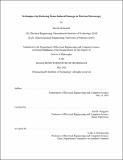Techniques for Reducing Beam-Induced Damage in Electron Microscopy
Author(s)
Abedzadeh, Navid
DownloadThesis PDF (42.44Mb)
Advisor
Berggren, Karl K.
Terms of use
Metadata
Show full item recordAbstract
Imaging biomolecules in their natural state at an atomic scale resolution is crucial to the un- derstanding of such molecules. Under the banner of Quantum Electron Microscopy (QEM), two novel electron microscopy schemes have been proposed to achieve nanometer-scale resolution while practically eliminating beam-induced damage to biological samples. The first approach is based on a quantum mechanical principle known as interaction-free measurement (IFM) and the second approach is known as multipass transmission electron microscopy, a type of phase contrast imaging in which the probe electrons transmit through a thin sample multiple times. I have been involved in the development of major components of the IFM scheme such as electron mirrors and diffractive electron mirrors for lossless splitting of incident electron beams. Further- more, I have made major progress in developing various components of the simplest form of multipass microscopy which could be performed in a scanning electron microscope. I developed a theoretical framework to understand the effects of beam shift and hydrocarbon contamination in multipass microscopy and the limit they place on the choice of sample in this scheme. This experiment would be the first demonstration of contrast enhancement due to multipassing in an electron microscope.
Date issued
2022-05Department
Massachusetts Institute of Technology. Department of Electrical Engineering and Computer SciencePublisher
Massachusetts Institute of Technology